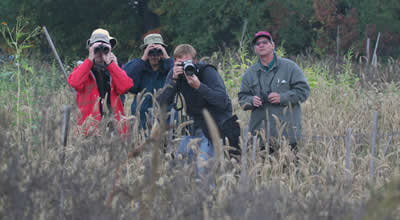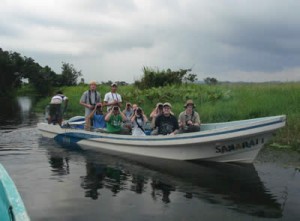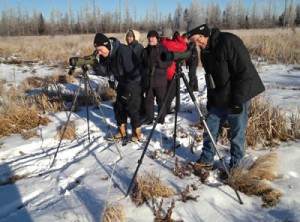
Birders sighting birds, identifying them and taking photos. Photo credit: Chris Wood.

Birders sighting birds, identifying them and taking photos. Photo credit: Chris Wood.
Birds are among the world’s best ecological indicators. eBird allows volunteers anywhere in the world to submit data about the birds they see at any time and in any location. The millions of observations recorded each month, logged into a central database at the Cornell Lab of Ornithology, are building a global understanding of the distribution, abundance and movements of thousands of bird species. The information is used by scientists, land managers, and bird watchers to document changes in bird distributions, pinpoint bird populations in need of conservation, and locate places to find new birds.
Download this case study (PDF, 170KB)
Website: eBird
Volunteers submit information about the kinds and numbers of birds they see at any location by clicking on an interactive map, which brings up a “smart” checklist containing the names of species likely to be seen in that location at that time of year. They enter data, which can include numbers of individual birds, nesting status and photos, into the form and submit the information to the Lab of Ornithology. Participants can view the accumulated eBird data on any species as a series of range maps, graphs and charts. The project allows bird watcher volunteers to keep detailed and accurate personal records of all of their bird sightings. They can refer to their records any time.

Birders looking for birds from a boat. Photo credit: Chris Wood.
eBird ensures data quality by managing a team of hundreds of regional editors around the world who control the fields in the data forms and check submitted records for accuracy. The project also partners with dozens of organizations around the world to manage local versions of eBird so that the project is sensitive to cultural and regional differences in bird-watching practices.
eBird documents the abundance and distribution of most of the world’s bird species, which can be tracked over time by anybody with access to the Web. eBird data have been used in more than 100 peer-reviewed publications in scientific journals.

Birders in a field viewing birds with scopes on tripods. Photo credit: Chris Wood.
The eBird case study illustrates the following steps in the Federal Citizen Science and Crowdsourcing Toolkit:
Rick Bonney
Email: reb5@cornell.edu